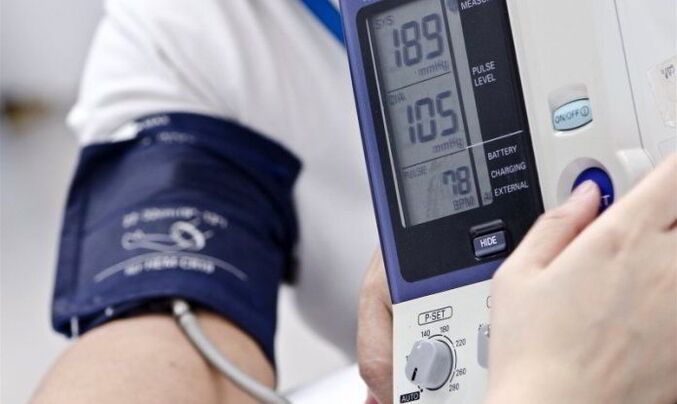Cervical osteochondrosis is a disease of the spine, which is characterized by intervertebral discs disorders.The pathology is characteristic of the elderly, but a person of any age can meet her.Tangible discomfort causes one of the main signs of this disease: severe pain.The patient must know what is dangerous cervical osteochondosis and what problems will face.
The details of the disease
The cervical region is one of the most mobile parts of the body and meets regular loads.With the development of osteocondrosis, the movement of the vertebrae, which leads to the compression of numerous vessels and nerves.The main complexity of the pathology is that its characteristic dystrophic changes influence the roots of the spinal nerve and the discs of the intervertebral space.For this reason, the brain remains without the necessary oxygen, the blood supply is lost.

In the risk area, there are mainly elderly people in which the disease develops against the background of metabolic disorders and the changes in the structure of the vertebrae and intervertebral discs are related to age.The reason for the development of these violations can also be:
- salt deposition;
- insufficient physical activity;
- improper nutrition;
- injuries;
- frequent hypothermia;
- Hormone problems;
- Excess weight;
- Chronic diseases.
Osteocondrosis also causes a long -term presence of the body in a position, which stages employees and office drivers.
Symptoms of osteochondrosis
In the initial phase of the disease, the symptoms are almost invisible, anxiety can cause only slight pain in the neck.But as the pathology develops, the symptoms are gradually increasing.
The osteochondrosis of the cervical column can be identified by the following signs:
- severe neck pain, cloud, shoulders;
- regular migraine;
- weakness of the hands;
- Neck mobility is limited;
- When turning the head, the vertebrae are creaking;
- Hearing problems;
- A characteristic sound appears in the ears;
- Discomfort in the throat.
In the initial stages, pain syndrome manifests itself only during movement, when it tilts or turns the neck.Over time, pain also occurs when the position of the hands changes.
Possible complications
If the cervical osteochondrosis is not treated, the degenerative processes on the intervertebral discs will lead to the loss of their main functions and the decrease in density.The excessive mobility of the spine will develop gradually, the muscles, joints and ligaments will suffer.The pressure on nerve endings and spinal cord will intensify, which will lead to an increase in symptoms and the development of new pathological phenomena.

Frequent migraine
To the most common consequences of osteochondosis of the cervical column, it is possible to calculate a headache.This happens because it is on this site that the vertebral artery is located, which is responsible for the delivery of oxygen and blood to the brain.
As the strength of the disc changes, the amortization functions are violated.The deformed vertebrae press on the artery, interfering with the blood circulation and "childbirth" of oxygen necessary.Muscle cramps are developing.
Following the pain, concomitant symptoms often follow:
- nausea;
- vomit;
- a strong increase in pressure;
- tingling in the shoulder blades;
- Weakness throughout the body.
With serious attacks, it is desirable to relax as much as possible, it is better in a horizontal position.An unpleasant syndrome can remove pain relievers or cold impatient, while the massage is useless.
Problems with vision
The complications of the cervical osteochondrosis often influence the organs of vision: in this section of the spine there are sleepy and vertebral arteries, which are responsible for the blood flow to the visual central structure.The compression of the nerve roots and blood vessels brings to hype and cause a decrease in vision.
Together with the vertebral artery syndrome, symptoms such as:
- fog;
- dark in the eyes;
- the appearance of "flies" or colored points;
- bifurcation;
- excessive stress of the optical nerve;
- dizziness;
- nausea.

During the exam, a specialist may see a narrowing of the arterial vessels of the retina of the eye, less often there is swelling of the optic nerves.Furthermore, in the background of the disease, glaucoma may appear, accompanied by an increase in intraocular pressure and pain.
Hearing problems
Due to the compression of the vertebral artery and the nerve roots, the loss of hearing is possible 20-30%.Neglected cervical osteochondosis can lead to uniform deafness.To avoid it, you need to contact a doctor at the first symptoms of the disease.
A slight reduction of hearing is reversible: in addition to the pharmacological treatment prescribed by a doctor, the patient needs special exercises or ear loss massage.Watching TV or listening to music is better in a small volume to strive for the hearing organs.
Hypotension or hypertension
Reduced or increased blood pressure are quite common consequences of cervical osteochondrosis.The greatest danger is hypertension, which are characteristic:
- Wrist ocomuation;
- increased sensitivity to temperatures;
- sleep disorders;
- nasal bleeding;
- dyspnea;
- Heart pain;
- Sweating.
The greater the blood pressure, the greater the load falls on the heart, which leads to its rapid wear.Consequently, heart failure develops.In hypertension, atherosclerosis develops faster, which is dangerous with a brain stroke.
Hypotenia does not represent a direct threat to life, but affects its quality significantly.The body experiences the hunger for oxygen, which affects the general well -being of the patient.Hypotonia is characterized by violations of the venous and arterial blood flow, and this involves ailments in the sensitivity of the limbs.Among the possible complications are the myocardial infarction.

Vegetations -Vascular stonia
Vegetable dystonia -vascular is a general designation of syndrome, which can affect different systems and body organs.Most of the pathology, the cardiovascular system and peripheral nerves suffer from pathology.The patient experiences constant anxiety and strong emotional differences.Frequent panic attacks are also possible and the heart rate becomes more frequent.
The symptoms of dystonia can be lubricated or masked like other diseases.The consequences of the osteocondrosis of the cervical region in this case are not even the most pleasant.Therefore, the gastrointestinal tract often suffers: nausea and vomiting, diarrhea, constipation and severe abdominal pain.Cystypy or liver disorders are possible.Patients often complain of tachycardia, pressure and heart pain problems.
Intervertebral hernias
With an intervertebral hernia, the fragments of the disc are "protruding" in the spinal canal or fall.The initial phase of this pathology is called protrusion.The integrity of the intervertebral disc is not disturbed, but there is a slight protrusion of the bones in the spinal canal.At this stage, the pressure on the roots of the spinal cord, therefore the main symptom is the weak pain that occurs during movement.In the following stages, pain syndrome has improved.
The mobility of the vertebrae is gradually reduced.The muscle tension has improved, even if the patient seems to be in a relaxed state.You can also notice periodic weakness in the upper parts of the hands or in the wrists.The numbness of the hands appears and a tingling tingling often occurs close to the thumb.
This is what is dangerous osteochondosis of the cervical column with hernia: it has a serious load on the artery, which passes next to the spine and is necessary for the flow of blood correct blood to the brain.If an excessive pressure of the patient occurs, an ischemic stroke can be expected.
A great hernia is dangerous for the inflammation of the surrounding ligaments - this is fraught with cervical roots.Only timely treatment can prevent complications.The patient must carefully listen to his body and the first symptoms to consult a doctor.Suspicions should cause:
- acute attacks of nausea without visible reasons;
- dark in the eyes when moving;
- noise in the ears when you turn your head;
- Pull the sensations in the neck with a long living room in the erect position.
The most serious complications are the irreversible risk of paralysis of one or both hands.The atrophy of the cerebral nerve leads to this, which is found in the cervical region.If the hernia begins to put pressure on the blood vessels, they will gradually die, which will lead to an in charge of a number of organs.
Vestibular bar syndrome
The vestibular bar syndrome is a condition in which the patient experiences a strong dizziness that accompanies the loss of orientation.
The attacks arise with a strong increase, turning or throwing their head back.State characteristic:
- noise in the ears;
- nausea;
- visual impairment;
- The feeling that everything turns and floats before his eyes.
The main reason for the pathology is the lack of blood supply, which involved dysfunction of the vestibular apparatus.The syndrome will occur more and more often as osteochondosis develops.
Glorious tiny syndrome
The osteochondrosis launched is dangerous with the neuro-vascular disorders of the throat and the larynx.The syndrome is characterized by:
- hoarseness;
- difficulty during swallowing;
- Constant feeling of a coma in the throat;
- dryness and pain;
- Complete loss of the item.
The syndrome occurs suddenly and is accompanied by dizziness.
Lieu bar syndrome
The second name of the pathology is the vertebral artery syndrome.The reason for its development is the stenosis (narrowing) of the vertebral canal, in which spasms of vertebral artery and compression of the blood vessels and nerves occur.
Symptoms include:
- hypertension;
- nausea;
- tachycardia;
- carve in the eye;
- noise in the ears;
- loss of coordination of movements;
- Pool pain in temples or in the occipital region.
With an acute movement or a rotation of the neck, the patient can lose consciousness.

Hypolamic syndrome
At the same time, the hypothalamus suffers from syndrome - a part of the brain that is responsible for metabolism, pressure, sleep, body temperature and emotional reactions of a person.Functional disorders can be manifested by improving or weakening the activity of the brain department.In the first case, the patient becomes irritable, in the second - inhibited.
Symptoms often resemble neurastenia, which manifests itself through:
- sleep disorders;
- resentment;
- irritability;
- high effort;
- Mood instability.
A person loses the opportunity to focus, there are problems with memorization.Unreasonable outbreaks of anger are possible, the appetite disappears, libido decreases.
It is better to prevent any disease than to treat, predicting the behavior of osteochondrosis is quite difficult.If there are risk factors, it is necessary to regularly perform a series of simple physical exercises that will increase the mobility of the vertebrae and eliminate congestion in the collar area.
The frequent aspect of any of the symptoms described is the obvious signal of the body on the problems that occur in it.At the same time, the car -marment is useless and without consulting a specialist will not work.

















































